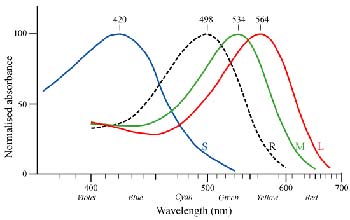While humans have three types of colour-detecting cells, mice and most other mammals have just two. But when a group of scientists gave mice the human gene for a third colour detector, they were able to detect colours that no mouse has ever seen before. This profound response to a simple genetic change may show us how our own vision evolved.
 Evolution is almost synonymous with small, gradual changes, and for good reason. We might expect that large changes to an animal’s genetic code, and therefore to its body plan, simply wouldn’t work. It would be like shoving an extra cog into a finely-tuned machine and expecting it to fit in – the more likely outcome is a malfunctioning mess.
Evolution is almost synonymous with small, gradual changes, and for good reason. We might expect that large changes to an animal’s genetic code, and therefore to its body plan, simply wouldn’t work. It would be like shoving an extra cog into a finely-tuned machine and expecting it to fit in – the more likely outcome is a malfunctioning mess.
But that’s not always the case, at least not for the evolution of the human eye. To Darwin, the eye was so perfect that it made him cast serious doubts over his theory of evolution.
But new research shows that the eye and its connections to the brain are surprisingly flexible, and can incorporate major evolutionary changes with ease.
In our retinas, cone cells are responsible for giving us colour vision. Most mammals have just two types, one that is sensitive to short violet-ish wavelengths of light (S cones), and another that responds strongly to medium greenish-blue wavelengths (M cones).
But somewhere in our history, humans and many other primates picked up a third cone sensitive to longer wavelengths (L cones), that allows us to see colours near the red end of the spectrum.
You might expect that adding another type of cone cell into the eye would be a very large step, requiring substantial (and gradual) changes in the wiring of both the retina and the brain. But Gerald Jacobs from the University of California has shown that it’s as easy as installing new software into your computer.
 Together with Jeremy Nathans from Johns Hopkins Medical School, Jacobs genetically engineered a strain of mice that had human L cones in addition to its medium and short-wavelength ones.
Together with Jeremy Nathans from Johns Hopkins Medical School, Jacobs genetically engineered a strain of mice that had human L cones in addition to its medium and short-wavelength ones.
Using a technique called electroretinography, they confirmed that these added cones were in full working order and were sending electrical outputs to the brain. They were clearly providing visual signals, but did this translate into any meaningful information in their brains?
Nathans and Jacobs set the mice a challenge to test their new retinal powers. They were shown three panels lit with coloured lights and had to pick out the one that was lit differently.
The normal mice failed to tell the difference between greenish-blue and yellowy-orange lights. They only chose correctly about a third of the time – the success rate you’d expect from random guesswork.
But the triple-coned mice passed with flying colours, so to speak. After lengthy training, they picked the odd panel out up to 80% of the time. Their genetic change had clearly been smoothly slotted in to their nervous system. They were seeing in three colours.
 The success of Nathans’s experiment is testament to the tremendous flexibility of a mammal’s nervous system. And it gives us a tantalising glimpse into how modern primate vision evolved.
The success of Nathans’s experiment is testament to the tremendous flexibility of a mammal’s nervous system. And it gives us a tantalising glimpse into how modern primate vision evolved.
At some point in our evolutionary past, one of our ancestors was born with a mutation that gave it a third and slightly different type of cone cell. This change would have brought it an instantaneous competitive edge over its two-coned peers.
Having three types of cones, rather than two, greatly expands the range of light that an animal can detect, and gives it a much broader colour palette. Such an animal would have gained a deeper appreciation of its surroundings than its peers – its eyes would quite literally have been opened to new possibilities.
Some scientists believes that the key advantage lay in being able to discern unripe green fruit from ripe ones that are typically red or orange. The bright colours of fruit may even have co-evolved with the advent of three-coned primate vision, to take advantage of these new seed-dispersing agents.
Over future generations, these new visual powers would have been honed by further genetic changes, but it is highly likely that the initial genetic jump-start would have spread like evolutionary wildfire.
The same may even apply to other senses, like taste and smell, with new genetic changes caused profound effects by adding new receptors and expanding an animal’s sensory range.
Reference: Jacobs, Williams, Cahill & Nathans. 2006. Emergence of novel colour vision in mice engineered to express a human cone photopigment. Science 315: 1723-1725.
Technorati Tags: colour vision, colours, sight, eye evolution, vision, evolution, eyes, science
Filed under: Animal kingdom, Evolution, Eye evolution, Genetics, Mammal evolution, Mammals, Mind and Brain, Neuroscience, Rats & mice, The Brain |











This may seem like a silly thing to say. But the thing I really love about evolution is the way things create these recursive effects throughout ecosystems. So one change affects the balance and creates these offshoots in a thousand different directions.
I’m talking about this bit:
‘Some scientists believes that the key advantage lay in being able to discern unripe green fruit from ripe ones that are typically red or orange. The bright colours of fruit may even have co-evolved with the advent of three-coned primate vision, to take advantage of these new seed-dispersing agents.’
The world is a rich and wonderful place.
Thanks for exciting me.
Hey Alabaster, that’s not a silly thing to say at all – I think it’s pretty much the right way to view things. Welcome aboard!
i need your permission, i want to place one of your pic in your site/blog, into my website, thanks for cooperation..